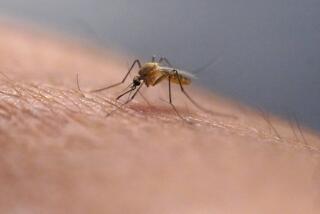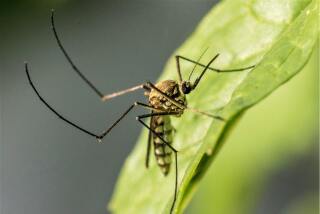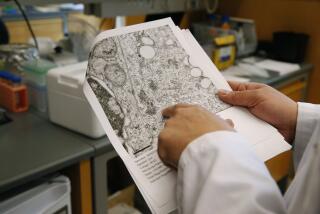Rise in Viral Meningitis
Cases of viral meningitis have more than tripled in Southern California this year, health officials reported Friday.
But they said the surge in the highly infectious, flu-like disease is not a cause for heightened public concern.
This more benign viral form of meningitis, an inflammation of the membrane of the nervous system, sometimes leads to hospitalization for patients who have lost food and fluids through vomiting, experts said. But sufferers nearly always fully recover within a week or so, they said.
“There is a much higher incidence of viral meningitis this year, but it’s still a rare condition,” said Dr. Robert Schechter, a physician at the state Department of Health Services. “Patients should seek care, but they should be assured that this is unlikely to affect their family in the long term.”
Experts blame a particularly virulent strain of meningitis for the increase in cases--especially in Southern California--in 1998.
So far this year, Orange County had the most cases of viral meningitis: 340 through last Saturday. That’s nearly triple the 125 cases reported in the same period last year.
“It is cyclical,” said Dr. Hildy Meyers, medical director of the Orange County Health Care Agency. “It is a seasonal occurrence, mostly in the summertime, but it also cycles over a period of years. We don’t really know why that is.”
The cycles may be related to levels of immunity in the community or the introduction of new viruses, Meyers said, but health officials can’t be sure because few doctors do a culture test in cases of viral meningitis.
Ventura County’s cases have increased more than five times over its 1997 level, health officials said, from 16 to 86. Statewide, cases are about double that of last year: up to 1,900 as of Sept. 5.
In all, cases in six large Southern California counties increased from 409 in the first eight months of 1997 to 1,284 over the same period this year. That represents the highest rate of the illness in the region and the state in the 1990s, according to state data.
The affliction--marked by pounding headaches, stiff necks and nausea--also tends to strike children rather than adults. The illness is often passed at school and day-care facilities.
“It is very difficult to prevent transmission from child to child and from child to family because of the close contact,” said Schechter of state health services. “It’s harder for children to have good hygiene all the time than it is for adults.”
But after peaking in the first two weeks of August, the incidence of new cases leveled off and appears to be dropping, said Dr. Robert Levin, health officer in Ventura County.
Unlike the more dangerous bacterial meningitis, which can kill, viral meningitis is an extremely uncomfortable but low-level swelling of the membranes that surround the brain and spiral column.
“This makes you feel horrible when you get it,” Levin said. “But you get better. There are some severe forms of viral meningitis, but this does not appear to be one of them. And luckily they’re very unusual.”
Viral meningitis is commonly spread by airborne viruses that cause fever, headaches, vomiting and diarrhea, officials said.
Spread of the virus can be slowed by washing hands with soap and water before eating or cooking and after visiting the restroom--and by not sharing drinking glasses, authorities said.
Affected students should stay out of school, doctors said. Some schools quarantine students with the more serious bacterial meningitis, but viral meningitis is usually taken in stride.
“It’s just a matter of keeping sick kids at home,” Schechter said. “And in a week or two they are as good as new.”
Staff writer Daniel Yi contributed to this report.
More to Read
Sign up for Essential California
The most important California stories and recommendations in your inbox every morning.
You may occasionally receive promotional content from the Los Angeles Times.









